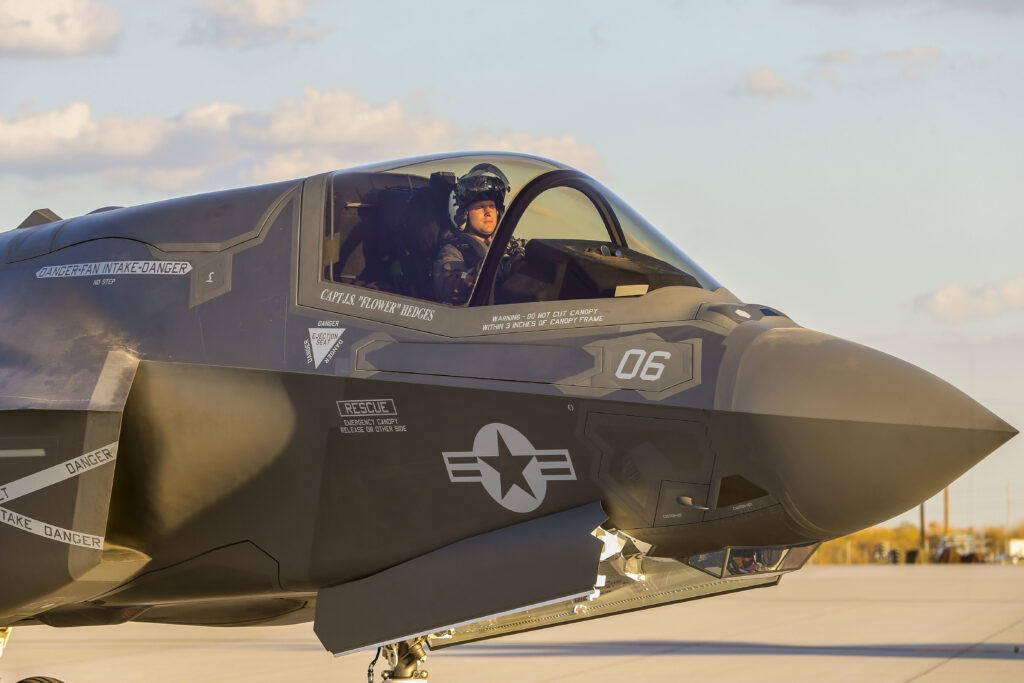
ARLINGTON, Va. — The Marine Corps plans to reduce the number of F-35 Lightning II strike fighters planned for some Marine fighter attack squadrons but is not reducing the program or record of 420 F-35s.
In the 2022 Marine Corps Aviation Plan released this week, the Corps shows it will reduce the number of F-35Bs in some squadrons from 16 to 10 aircraft. Originally the 16 were going to allow for a six-plane detachment on board an amphibious assault ship in addition to a 10-plane land-based force. In the current plan, all F-35B (and carrier-capable F-35C) squadrons will be equipped with 10 aircraft.
The plan for F-35 squadrons is in accord with Marine Corps Commandant David H. Berger’s Force Design 2030 plan for restructuring the Marine Corps.
Lt. Gen. Mark Wise, deputy commandant for Aviation, speaking to reporters May 2 at the Pentagon, said the change in the numbers in the F-35 squadrons “really had to do with what is the optimum way, so starting with the requirement and moving backwards.
“The F-35 is designed to deploy as a division, so 10-airplane [squadrons] were designed to field two divisions with two [aircraft] in backup,” Wise said. “That is the model that we believe is the right direction to go for a Marine expeditionary unit. That way you’re deploying a whole squadron as well. You’re not leaving pieces of it behind. So, you don’t have a command element that’s got to go to one side or go to the other side. With that said, we will continue to learn and evolve and experiment and wargame and do all the things we’ve been doing to make sure that number is right. We have to make sure that the rest of the ACE [Aviation Combat Element] on board the L-class ships, are the numbers are balanced appropriately? Do they all fit? Is all the maintenance able to be done? So, there’s some experimentation to go to make sure we’ve got it perfectly right, but we think we’re off to a pretty good start.”
Wise said that “overall, our POR [program of record] still remains the same [at 353 F-35Bs and 67 F-35Cs] because if you look at the entirety of the program from start to now, there were certain affordability decisions made early on that had to do with things like our attrition model was truncated in order to meet affordability concerns. So, if you take the attrition model and expand it back to the numbers that we have for those 18 active and two reserve squadrons, your number actually ends up being our POR.”
The Corps intends to upgrade all of its existing F/A-18 Hornet-equipped Marine fighter attack (VMFA) squadrons and convert the remaining AV-8B Harrier II Marine attack (VMA) squadrons to VMFAs. Two more squadrons — one a reserve unit — will be reactivated, while another will be deactivated for about four years and will be reactivated as an F-35C squadron. In all, the plan has the Corps fielding 14 active component and two reserve F-35B squadrons and four active component F-35C squadrons by fiscal 2032.
The Corps also has two F-35B fleet replacement squadrons, one on each coast. (F-35C training will remain with the Navy’s fleet replacement squadron, VFA-125.) The F/A-18 Hornet fleet replacement squadron, VMFAT-101, will be deactivated in fiscal 2024 and turn its training responsibilities to VMFA-323, a deploying squadron which will maintain a fleet replacement detachment until fiscal 2027.
Of the Corp’s six remaining active-component Hornet squadrons, five now fly a mix of seven single-seat F/A-18Cs and five two-seat F/A-18Ds. VMFA-323 will retain F/A-18Cs and reserve VMFA-112 will give up its last four F/A-18A++ versions to become an all “C/C+” squadron.
The four existing Harrier squadrons, all based at Marine Corps Air Station Cherry Point, North Carolina, now fly only the radar-equipped version of the AV-8B. One squadron, VMA-223, also runs a fleet replacement detachment that includes two-seat TAV-8Bs. The Harriers are slated to be phased out in fiscal 2027.
- SECNAV Advocates Increased Legal Immigration to Increase Shipbuilder Workforce - April 23, 2024
- Insitu Going Strong at 30, Focusing on Maritime Operations - April 8, 2024
- Navy Awards Boeing Additional Funds for MQ-25 Drones for Testing - April 3, 2024






